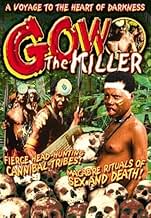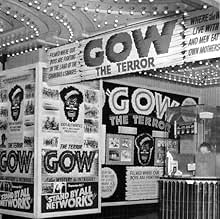Aggiungi una trama nella tua linguaExplorer Edward Salisbury takes an expedition across the Pacific Ocean to such exotic places as Fiji, Samoa, Papua New Guinea and the New Hebrides, and records the lives of the diverse nativ... Leggi tuttoExplorer Edward Salisbury takes an expedition across the Pacific Ocean to such exotic places as Fiji, Samoa, Papua New Guinea and the New Hebrides, and records the lives of the diverse natives he encounters there.Explorer Edward Salisbury takes an expedition across the Pacific Ocean to such exotic places as Fiji, Samoa, Papua New Guinea and the New Hebrides, and records the lives of the diverse natives he encounters there.
- Regia
- Star
Recensioni in evidenza
Numerous ethnographically flavoured documentaries were released in the United States during the late 1920s and on into the early 1930s, forerunners of the "Mondo" exploitation films, emblems of the related dross that appeared three decades after, and of them all this is one of the best and most grounded in reality, including as it does authentic footage shot during Edward A. Salisbury's expeditions into the South Seas, although it also incorporates staged sequences in addition to creative use of stock footage to offset alleged "censorship" difficulties. Released by Real Pictures, the film is narrated by regular Salisbury companion William Peck whose laconic irony is often hilarious as we view the visually exciting adventures experienced by a crew of 18 along with 13 "scientists" aboard skipper Salisbury's 161 foot long sloop "Gypsy" sailing from San Pedro (Port of Los Angeles) as the vessel wends its way into the Pacific Ocean 3000 miles to the Marquesas Islands and beyond to other exotic locales. We watch as Marquesans fish with spears and collect mangoes and breadfruit, and then it is on to Samoa where, to please Salisbury and his men, Samoan women perform seated (Siva) dances that relate of local history that is not elsewise recorded. Another 450 miles takes the adventurers to Fiji, a British Crown Colony at the time of this production. Warriors there (Peck points out that there had not been a war on Fiji for 75 years, yet all of the Fijian men are warriors, although all that they do is dance) treat viewers to a splendidly synchronized Dance of the War Clubs. Upon leaving Fiji, the expedition sails for Melanesia, and the documentary becomes a bizarre mixture of fact, fantasy and the recondite. A significant stop is at the Andaman Islands in the eastern Bay of Bengal, present habitat of its original residents, diminutive Pygmies, the most primitive group of all the natives seen in the film, since they have no residences, simply sleeping in convenient trees, and have not discovered the use of fire, therefore being restricted to raw food. These former cannibals are filmed during a wedding ceremony and we also see women who have become widowed wearing the skulls of their late husbands suspended from their necks. Such authentic touches of thoroughly uncivilised peoples lead us to the film's final scenes, these depicting cannibals and headhunters. Following a visit with Papuans, erstwhile but recent cannibals residing along the coast of New Guinea, the voyagers move along to New Hebrides and the Western Solomon Islands where black Melanesians still practice their dispiriting customs. Here we finally meet the eponymous Gow, high chief of Solomon Island headhunters who recreate for the camera eye a tribally combined raid, under the leadership of Gow, attacking rivals who had kidnapped his daughter. This action comprises the film's climax, but is actually not as interesting as what preceded it during a work that provides agreeable entertainment throughout its brief length.
The arrogance of the narrator, resting on the confidence that he hails from a culture that has reached the ultimate apex of development, as he dismisses what he sees as the folly and wasted lives of savages, provides many belly-laughs. We are supposed to simultaneously believe that these are childlike simpletons and ruthless satanic beasts. As the narrator's culture rapidly destroys itself and its planet, including the happy hunting grounds of these supposed wild animals dressed like dolls, you can sit back and roar in appreciation that you, too, are 'civilized'.
One thing the narrator gets right: mangoes are good, but you have to get over the initial hint of turpentine.
One thing the narrator gets right: mangoes are good, but you have to get over the initial hint of turpentine.
Gow the Killer (1931)
** (out of 4)
Fairly interesting documentary from Edward A. Salisbury about various expeditions to South Pacific islands where we're introduced to cannibals, savages and other humans. Basically this is an early version of the "Mondo" genre, which would become even more popular in the 1960's. The footage here is pretty interesting, although most of it was shot silent with narration added. The narrator isn't too interesting and brings the film down some so releasing this as a silent might have been a better idea. There's some pretty funny moments including one scene where a cannibal explains why white and black men taste differently. Another funny segment is a group of cannibal men who are afraid of a rival gang so they always send their women out to do the meetings.
** (out of 4)
Fairly interesting documentary from Edward A. Salisbury about various expeditions to South Pacific islands where we're introduced to cannibals, savages and other humans. Basically this is an early version of the "Mondo" genre, which would become even more popular in the 1960's. The footage here is pretty interesting, although most of it was shot silent with narration added. The narrator isn't too interesting and brings the film down some so releasing this as a silent might have been a better idea. There's some pretty funny moments including one scene where a cannibal explains why white and black men taste differently. Another funny segment is a group of cannibal men who are afraid of a rival gang so they always send their women out to do the meetings.
Trama
Lo sapevi?
- ConnessioniEdited from Gow the Head Hunter (1928)
I più visti
Accedi per valutare e creare un elenco di titoli salvati per ottenere consigli personalizzati
Dettagli
- Data di uscita
- Paese di origine
- Lingua
- Celebre anche come
- Cannibal Island (1956)
- Luoghi delle riprese
- Vedi altri crediti dell’azienda su IMDbPro
- Tempo di esecuzione1 ora 1 minuto
- Colore
- Mix di suoni
- Proporzioni
- 1.20 : 1
Contribuisci a questa pagina
Suggerisci una modifica o aggiungi i contenuti mancanti








